How to clean the gas column: methods available for independent implementation
If the house has a geyser, one day the question arises about its maintenance. The heat exchanger of such a device is gradually overgrown with calcareous deposits, and soot and soot particles settle on the burner. It is better to immediately find out how to maintain the equipment in good condition so that it does not fail prematurely.
We will tell you how to clean the gas column with your own hands if calling a representative of the gas supplying service is optional. In our article, we describe methods for removing carbon deposits and other combustion products from important working bodies of a flowing water heater. Tips for preventing the formation of hazardous deposits are given.
The content of the article:
The principle of operation of the instantaneous water heater
The geyser is a relatively simple device for heating water. Above is a heat exchanger connected to the plumbing system. Below it there is a burner that is connected to a gas pipe.
In all modern models, the ignition of the burner is automated, only very old or defective models are manually ignited. The latter should be repaired in order not to risk the health of households and the integrity of property.
The design is hidden by a protective casing, on the front panel of which the control unit is usually located. It regulates the maximum temperature of water heating, the amount of gas and other indicators of the device. At the top there is a cap and a chimney pipe through which combustion products are removed.
When water is opened in the house, the burner automatically turns on, the gas warms up the water to the required temperature. Auto-ignition is configured so that the column is turned on only with a sufficiently high water pressure in the system. Another important indicator is the presence of good traction.
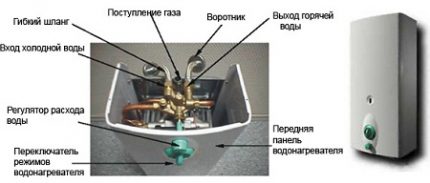
The process of heating water is accompanied by the precipitation of a hard precipitate, which gradually accumulates inside the heat exchanger.The tubes become clogged with deposits, as a result, the quality of heating deteriorates, work instantaneous water heater becomes insufficiently effective.
Regular column cleaning will help to avoid such problems. In addition to scale inside the device, other contaminants can also collect, it all depends on the quality of the water.
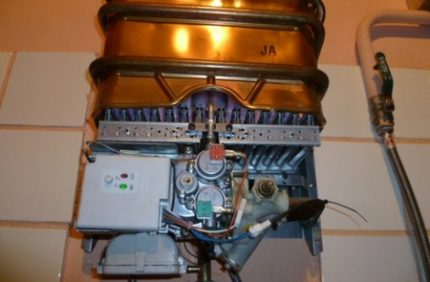
The following signs indicate that it is time to clean the column:
- the pressure from the tap with hot water is much weaker than the stream from the cold tap;
- the pressure is good, but almost immediately after switching on, the column goes out;
- the device generally stopped turning on regardless of pressure;
- insufficient flow heating is observed in comparison with the previous state;
- water is heated to the desired temperature, but too slowly.
Some malfunctions can also be observed when the shut-off valve, which is installed at the entrance to the column, is broken. It does not hurt to first check it, and only after that proceed with cleaning.
Descaling procedure
To flush the heat exchanger gas column, you must first find the valves that block the flow of gas and water to the device, and then turn them.
At the same stage, it is recommended to get the instruction manual and refresh the memory of the device’s device, as well as the manufacturer’s recommendations. This will avoid errors during dismantling.
To disassemble the column, you will need the usual tools that are available to any experienced master:
- adjustable spanner and pipe wrench;
- straight and Phillips screwdrivers;
- paronite gaskets;
- hose at least half a meter long;
- a metal collar to fix this hose.
The hose is connected to the outlet of the heat exchanger and lowered into the sink so that waste water with impurities can be drained into the sewer. If this is not possible, you will also have to stock up on a sufficiently large tank to drain the water. The protective cover is removed from the column. Be careful not to break the control panel.
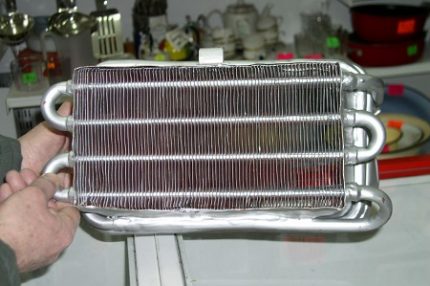
Now you need to remove the water filter, which is usually fixed with a nut. In the future, the filter should be washed and installed in place. If deposits are too complex, it is recommended to use chemical cleaners to remove contaminants from the net. During the flushing process, filter damage can be detected. In this case, it is better to replace it.
Now you need to disconnect the heat exchanger from the water pipes, usually in these places the usual threaded connection is used, which you just need to unscrew. The heat exchanger is removed from the hinges and turned over. Some craftsmen advise to put it in a spacious enough tank for cleaning time so that aggressive chemicals do not leak onto the floor.
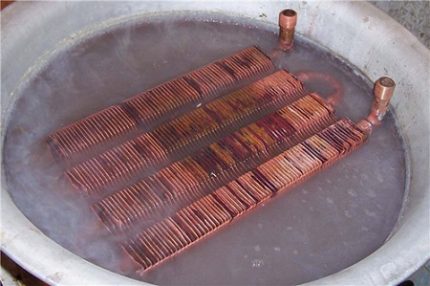
As a cleaner, you can use suitable products, for example, “Anti-scale. An ordinary 9% solution of vinegar and other household compounds are also suitable. You can make a solution of citric acid: 100 g per liter of water.
Some have positive experience with descaling with Pepsi-Cola or Sprite drinks that contain phosphoric acid. But do not use vinegar essence for these purposes, it can corrode the walls of the pipes, you will have to carry out a serious repair.
The heat exchanger is turned over and the purifier is poured into it using a rubber bulb or a large syringe. Usually you need at least 500 ml of the substance, but not more than a liter.After that, vinegar or citric acid is left inside for about a quarter of an hour. When using industrial cleaners, it is recommended that you follow the instructions.
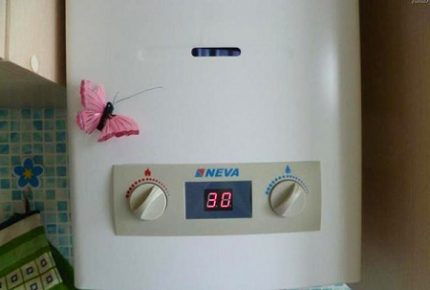
At the end of cleaning, the solution is drained, and the pipes are washed from accumulated dirt. To do this, the heat exchanger inlet is again connected to the water supply, and a container is placed at the outlet to collect dirty water.
Rinsing is performed until a clean jet appears. If there is serious contamination, a single cleaning procedure may not be enough, it will have to be repeated again using a fresh portion of the cleaner.
Upon completion of work, it is necessary to assemble the column in the reverse order. The heat exchanger is connected to the water supply. At the same time, threaded connections should be sealed and treated with graphite grease. All gaskets available at installation sites must be replaced immediately with new ones.
Now it is necessary to replace the washed coarse filter, put on the casing on the device and again supply gas and water to the column by unscrewing the corresponding valves. It remains to carry out a test run of water to make sure that the column is working properly.
Heat exchanger cleaning without dismantling
There is also a way to clean the heat exchanger without completely dismantling it. To do this, first remove the casing from the device and disconnect the water supply pipe from the heat exchanger. The inlet copper tube of the coil should be slightly shifted to make it more convenient to work.
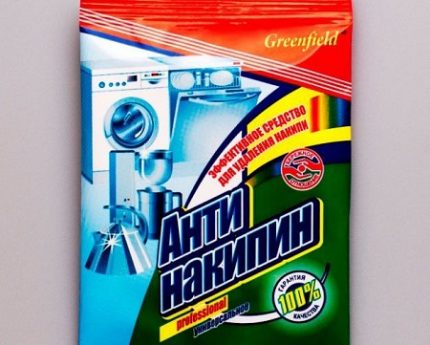
Put a hose on the outlet pipe. Then you need to open the tap and drain a little water, about a liter, to free the coil from the liquid. If it is possible to specify the capacity of the heat exchanger in the technical passport gas column, it is recommended to drain exactly that amount of water from the system or a little more.
To clean the column using this method, it is better to take the “Anti-scale” powder, which is diluted with hot water before use. It does not hurt to take care of protecting the skin and eyes from accidental exposure to the composition, since it contains hydrochloric acid.
Now you need to insert a funnel into the inlet pipe and pour it into the “Anti-scale” heat exchanger. It should be remembered that with quick pouring inside, a reaction may begin that will lead to the expulsion of the hazardous solution in the opposite direction. Therefore, pour the composition in small portions and a thin stream.
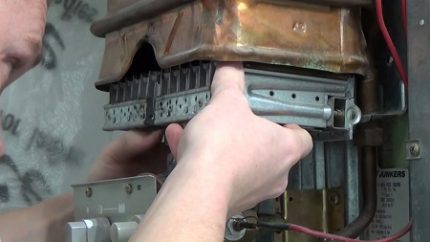
The heat exchanger charged with the solution should be left for approximately two hours. To speed up the cleaning process, you can turn on the igniter (gas for this cleaning method is not necessary to shut off). When the process is over, you should open the tap and drain the water from the column with the sludge dissolved in it.
If there is a lot of contamination, and the jet shows a good head, cleaning can be considered satisfactory. If not, you need to carry out the procedure again, but when using “Antinakipin” such a need usually does not arise.
This cleaning method is recommended using just such a cleaner. The use of vinegar or citric acid in this case can adversely affect the condition of the aluminum gearbox.
Removal of pollution from combustion products
Soot, soot and other solid combustion products, although they are formed in such devices in small quantities, can still cause serious damage.
If you need to clean this part of the device, you must again recall the manufacturer's instructions, especially if the warranty period has not yet expired.Some manufacturers require that such work be carried out only by professional gas workers.
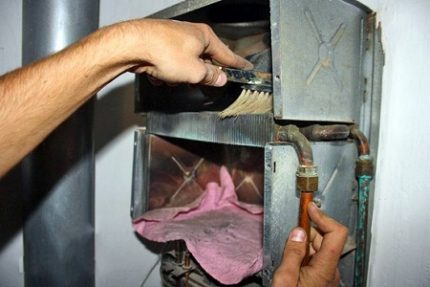
The easiest way to clean the column radiator from the combustion products. To do this, turn off the gas and remove the protective cover from the device. After that, the surface of the element is treated with an ordinary household vacuum cleaner.
If the gas in the column does not light up, or burns unevenly and weakly, nozzle clogging may occur. To clean them from the accumulated layers of soot, use a thin wire or brush with a pile of metal.
Of course, in this case, you should turn off the gas and remove the casing. Cleaning must be done carefully so as not to damage the elements of the device.
When the soot accumulates too quickly, it makes sense to think about the presence of other malfunctions that provoke this situation. A common cause of this phenomenon is a leak at the junction of the gas pipes inside the column.
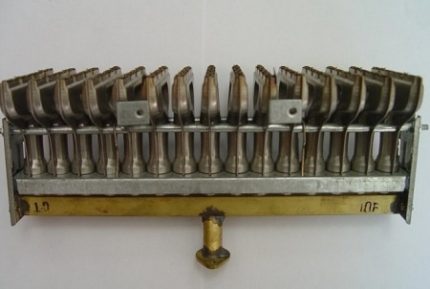
The gap can be so small that the leak cannot be detected by smell. If you suspect a malfunction of this type, you need to apply a soap solution to the joints, and then apply gas to the device.
If the solution begins to bubble, stop work, turn off the gas and immediately call an experienced gasman. Amateur action at this stage can be fatal.
The water pressure is normal, the soot is removed, but the column still does not turn on? It's time to check your cravings. In modern models, usually there are special sensors that detect the absence of traction and do not allow you to turn on the device, blocking the flow of gas to the ignition device.
For verification, it is better to use strips of thin paper. The flame of a candle or lighter can be dangerous if problems arise due to a gas leak.

Having found a weak craving, it is necessary to identify the cause of the situation. It is usually sufficient to clean the chimney to restore normal operation. If this does not help, it is worth consulting with a gas equipment engineer, there may be flaws made during the installation of the chimney structure.
Limescale Prevention
Hard water is not the only reason for the appearance of scale inside the tubes of the heat exchanger. For its appearance, not only salts that are contained in water are needed, but also a high heating temperature. The stronger the gas burns, the more intense the solid sediment falls out inside the device. A temperature of 80 degrees or higher is considered critical.

Obviously, such a strong heating for domestic use is not needed. 40-42 degrees are enough for a shower, 45 degrees are enough to wash even the dirtiest dishes. An automatic washing machine will heat water up to 95 degrees, if necessary, but the gas column is not involved in this process.
Therefore, if you have to breed hot water constantly, it’s worth revising gas boiler settings by heating temperature. Some amateur craftsmen drill the ignition of a gas column. This is done in order to increase the heating rate of the water flow.
In older models, this alteration eliminates the need to light and tune the device each time it is turned on. Finally, a drilled ignitor is needed so that the gas ignites even with a very low pressure of the water flow.
In this case, a very dangerous situation may arise when a small amount of water in the heat exchanger boils and passes into a gaseous form. As a result, the pressure in the heat exchanger will increase sharply and it will simply burst.
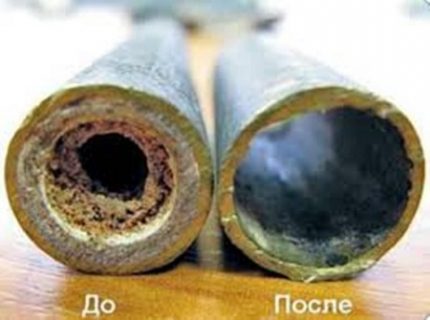
Of course, gasmen consider such interference to be dangerous, and manufacturers refuse to fulfill the warranty for devices with similar alterations. To improve system head, you can pick up and put the usual circulating device or boost pump. And the quality of water supply will improve, and appliances will not be affected.
Conclusions and useful video on the topic
An interesting option for flushing a gas column can be found in this material:
The procedure for cleaning the heat exchanger without dismantling is shown here:
This video shows an interesting experiment on the dissolution of scale in an electrolyte, citric acid and vinegar. Although it is necessary to take into account not only the effect of chemistry on the hard precipitate, but also on the material of which the heat exchanger is made:
Any geyser needs periodic cleaning. If maintenance is performed correctly, the device will work for a long time and efficiently.
Want to talk about how to clean a gas instantaneous water heater with your own hands? Do you have information on the topic of the article that will be useful to site visitors? Please write comments in the block below, ask questions and post a photo on the topic of the article.

 Conord gas boiler malfunctions: common breakdowns and solutions
Conord gas boiler malfunctions: common breakdowns and solutions 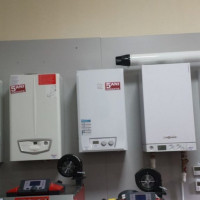 Immergas gas boiler errors: error codes and solutions
Immergas gas boiler errors: error codes and solutions 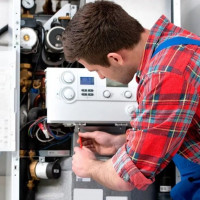 How to increase the efficiency of a gas boiler with your own hands: the best ways to increase the efficiency of the boiler
How to increase the efficiency of a gas boiler with your own hands: the best ways to increase the efficiency of the boiler 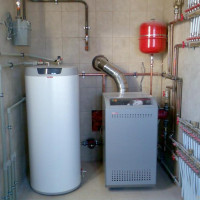 Why pressure drops in a gas boiler: causes of instability of pressure + ways to prevent problems
Why pressure drops in a gas boiler: causes of instability of pressure + ways to prevent problems  Rinnai gas boiler errors: trouble codes and ways to fix them yourself
Rinnai gas boiler errors: trouble codes and ways to fix them yourself  Kiturami gas boiler errors: trouble codes and troubleshooting
Kiturami gas boiler errors: trouble codes and troubleshooting  How much does it cost to connect gas to a private house: the price of organizing gas supply
How much does it cost to connect gas to a private house: the price of organizing gas supply  The best washing machines with dryer: model rating and customer tips
The best washing machines with dryer: model rating and customer tips  What is the color temperature of light and the nuances of choosing the temperature of the lamps to suit your needs
What is the color temperature of light and the nuances of choosing the temperature of the lamps to suit your needs  Replacement of a geyser in an apartment: replacement paperwork + basic norms and requirements
Replacement of a geyser in an apartment: replacement paperwork + basic norms and requirements
Good, interesting and informative information, but nevertheless, I think it is better to entrust this work to representatives of the gas service.
The column is not a joke, here you must fully understand the specifics of its work. If for self-development, then it’s worth knowing the subtleties of the device, but in practice I would not try to clean the column myself. For this, there are specially trained people who will do everything, and they will give a guarantee for their work!
“Specially trained people” - they will take a lot of money, and not the fact that great specialists. And they certainly do not work for themselves.
Citric acid is the best descaler.
I’ve been cleaning my gas boiler in my mother’s house for several years now. Usually before the start of the heating season. At the same time I check the AGV. Actually easier than it seems at first glance. Of course, at least the slightest idea of the device structure and the specifics of its operation needs to be known. The rest can be easily found on the Internet. The main thing to remember is that you need to act very carefully, and follow instructions carefully. I myself would not recommend using all sorts of folk methods, such as citric acid, etc. In the end, there are special tools for this, such as the same “Anti-scale”. It will cost several times cheaper than calling a “specialist,” who will look at your column several times with a very thoughtful look.
About the video “Flushing the column without dismantling”. Could it be easier?
1. Block the water.
2. Open the hot water tap.
3. Unscrew the filter.
4.Blow it several times so that the remaining water in the system comes out through an open hot water tap.
5. Lemon and so on.